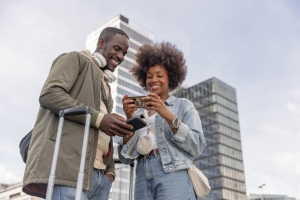Introduction
Managing money while traveling is an essential part of a hassle-free trip. Namibia offers a relatively straightforward financial system, but knowing how to handle cash, exchange rates, and digital payments will make your experience smoother. This guide covers everything from currency exchange to payment options, expected costs, and money safety tips.
Namibian Dollar (NAD) & South African Rand (ZAR)
💰 Namibia’s Official Currency:
- The Namibian Dollar (NAD) is the official currency, available in coins (5c, 10c, 50c, N$1, N$5) and banknotes (N$10, N$20, N$50, N$100, N$200).
- The South African Rand (ZAR) is also legal tender in Namibia and can be used interchangeably with the NAD at a 1:1 fixed exchange rate.
💱 Exchange Rate & Value:
- The NAD is pegged to the South African Rand (ZAR) at a 1:1 ratio, meaning one NAD always equals one ZAR.
- However, Namibian Dollars are NOT accepted in South Africa, so if you receive change in NAD, spend it before crossing the border.
👉 Tip: If traveling to multiple countries in Southern Africa, consider carrying ZAR instead of NAD for wider acceptance.
Currency Exchange & Where to Get Money
💵 Best Places to Exchange Currency:
- Banks – Offer the best exchange rates but may have longer queues.
- Currency exchange bureaus – Located at major airports and city centers, though they may charge higher fees.
- Hotels & lodges – Some high-end establishments offer currency exchange, but rates may not be favorable.
🏧 ATMs & Withdrawal Limits:
- ATMs are widely available in cities and towns but may be scarce in remote areas.
- Most ATMs accept Visa and Mastercard, though some may not support American Express.
- Daily withdrawal limits range between N$2,000 – N$5,000, depending on the bank and your card provider.
- Some ATMs charge withdrawal fees for international cards.
👉 Tip: Always carry some cash when traveling to rural areas, where ATMs may not be available.
Using Credit Cards & Digital Payments
💳 Where Credit Cards Are Accepted:
- Major hotels, restaurants, supermarkets, and tour operators accept Visa & Mastercard.
- Small shops, local markets, and rural businesses often operate on a cash-only basis.
- American Express and Diners Club are not widely accepted.
📱 Mobile Money & Online Payments:
- E-wallet services like e-Money and PayToday are growing in popularity, but they are mainly used by locals.
- Apple Pay, Google Pay, and PayPal are not widely supported.
👉 Tip: Always have backup cash, especially if traveling outside major cities like Windhoek and Swakopmund.
Cost of Traveling in Namibia
💸 Budgeting for Your Trip:
Namibia can be a budget-friendly or high-end travel destination, depending on your preferences.
Estimated Daily Costs:
- Budget travelers: $50–$100 (hostels, public transport, local food)
- Mid-range travelers: $150–$300 (lodges, rental car, guided tours)
- Luxury travelers: $400+ (private safaris, high-end lodges, charter flights)
Typical Costs:
- 🏨 Accommodation: $10–$500 per night (camping to luxury lodges)
- 🍽️ Meals: $5–$50 per meal (street food to fine dining)
- 🚕 Transport: Car rental from $50/day, taxis from $3 per ride
- 🎟️ Activities: Entrance fees to national parks ($5–$15), guided tours ($50+), balloon safaris ($400)
👉 Tip: Car rental and fuel costs are significant expenses—consider this when planning your budget.
Tipping & Bargaining Etiquette
💰 Who to Tip & How Much:
- Restaurants: 10–15% if service isn’t included in the bill.
- Tour guides & safari drivers: $5–$10 per day.
- Hotel staff (porters, housekeeping): $1–$3 per service.
- Petrol station attendants: Small tips (N$5–N$10) for pumping fuel and cleaning your windshield.
💬 Where Bargaining is Expected:
- Local markets & street vendors – Prices are often negotiable.
- Tourist souvenirs – Vendors may start with inflated prices, so polite haggling is common.
- Taxi fares – If using informal taxis, agree on a price beforehand.
👉 Tip: Bargaining is not expected in supermarkets, restaurants, or hotels.
Money Safety Tips
🚨 Avoiding Scams & Counterfeit Bills:
- Be cautious of money exchange scams—only use licensed exchange services.
- Inspect large banknotes carefully to avoid counterfeit bills.
- Never exchange money on the street.
🎒 Best Practices for Carrying & Storing Cash:
- Divide your cash – Keep small amounts in different places (wallet, money belt, luggage).
- Use hotel safes for storing extra cash and valuables.
- Avoid displaying large amounts of cash in public.
👉 Tip: Use credit/debit cards for major expenses and carry cash for small transactions and rural areas.
Conclusion
Understanding Namibia’s currency, payment options, and travel costs will help you budget and enjoy a stress-free trip. Whether you’re a budget backpacker, self-drive adventurer, or luxury traveler, being financially prepared ensures a smooth travel experience.
💡 Key Takeaways:
✅ Carry both cash and cards – ATMs and card machines aren’t always available.
✅ Use South African Rand (ZAR) if traveling to multiple Southern African countries.
✅ Plan for high fuel costs if renting a car for long-distance travel.
✅ Tipping is customary but not mandatory – show appreciation where appropriate.By keeping these tips in mind, you’ll be well-prepared to handle money matters in Namibia with ease! 💰✨








